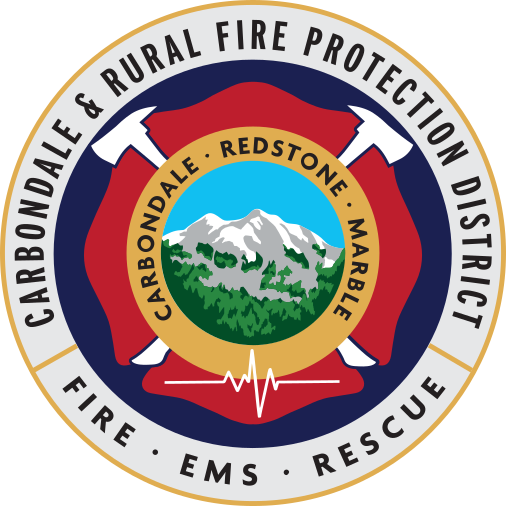Master Plan – Ballot Question 7B
By admin Published October 18, 2018

Carbondale & Rural Fire Protection District is on the ballot this November asking voters to consider two ballot questions. The first question (7B) is to increase the operating mill levy. The second question (7C) is to allow the District to bond $7.5 million for apparatus, buildings and equipment.
We know that our voters have questions on these proposals and we want to answer your questions. This post is about Ballot Question 7B, the Operating Mill Levy.
Master Plan
CRFPD’s 2015 master plan, developed by Almont Associates in conjunction with CRFPD, helped to identify a number of areas that are identified for improvement in order for CRFPD to safely staff emergency response and provide a high level of care.
24 Hour Response Staffing
- Concurrent Calls In 2015, CRFPD’s master plan addresses 24-hour response staffing levels. One area of response identified is known as Concurrent Calls. Concurrent calls refer to response on multiple calls that occur simultaneously. This is a very serious issue as 15% or more of CRFPD’s incidents happen concurrently. In 2017, concurrent calls happened 81 times or more than 1 ½ times a week, totaling almost 180 calls or 15% of the total calls for service.
- Ambulance Calls CRFPD currently staffs 3-4 on-duty 24 – hour responders per shift. A single ambulance call typically requires 3 responders to provide the highest level of care. Since CRFPD does not have a hospital in our district, patients are transported to Valley View Hospital in Glenwood Springs. This extended transport time keeps an ambulance and crew out-of-service for over an hour on a regular basis and the out-of-service time can be 2 ½ hours if the incident is in an area such as Redstone, Marble or even Missouri Heights.
- Motor Vehicle Accidents (MVAs) Motor Vehicle Accidents are a regular occurrence in the fire district and they are some of the most dangerous incidents to which CRFPD responds. Safely responding to a motor vehicle accident requires a minimum response that includes an ambulance and a fire engine. An ambulance crew of 3 is needed to access, treat and transport a patient. A fire engine crew of at least 3 is needed to provide assistance to the EMS crew, fire and spill control, scene management and safety. The minimum safe response to these incidents is 6 responders.
- First-Due Fire Response Structure fire response is one of the most dangerous activities that we do. Extreme heat and the threat of sudden structural collapse are two of the many hazards encountered on a structure fire. The recognized national staffing standard required before engaging in interior firefighting activities include: 2 firefighters inside, 2 outside (ready to go in to rescue or assist), 1 pump operator, 1 incident commander. This standard comes from the National Fire Protection Association (NFPA), after decades of studying firefighter fatalities and injuries on these incidents.
In addition, this is simply the “first due” response before operations can begin. NFPA standards require 15 total firefighters to safely conduct the 22 identified tasks in a structure fire.
Mill Levy Question
With the current mill levy question, CRFPD is asking to fund staffing levels that will eventually lead to a minimum of 6 responders per 24-hour shift. If approved, the new funding will allow CRFPD to staff an additional responder on each shift, bringing our staffing level to 5 per shift. Over time we will be able to add another 24-hour responder to each shift. This level of funding is vital to CRFPD’s ability to ensure responder safety and provide the highest level of Advanced Life Support care to our communities even if part of the crew is already out on another ambulance call.
Training
At CRFPD, we have long identified training as the “Golden Key” to our ability to successfully deliver a high standard of care to sick and injured patients and to safely respond to fire and rescue incidents.
Unfortunately, areas such as training have taken a big hit in recent years and we have not been able to fund training to the level that is needed to adequately maintain and improve the skills of the great full-time and volunteer staff at CRFPD. Delivery of quality training at CRFPD requires a multi-pronged approach as there are a number of areas in which we strive to be excellent:
- Emergency Medical Care – Advanced Life Support and Basic Life Support certification and continuing excellence.
- Structural Firefighting – Includes pumper operations, firefighting skills and tactics, ladder operations, search & rescue, etc.
- Wildland Firefighting – Initial firefighter certifications, engine operations, large group operations, incident management, aircraft operations.
- Swift Water Rescue – Certified levels of responders, large group operations, management of incidents.
- Technical Rescue – High and Low Angle rescue operations, technical rope rescue operations including downhaul and uphaul. Technical structural rescues.
- Backcountry Rescue – Large group operations, medical team response, victim access, helicopter operations, carry-out operations.
- Hazardous Materials – Multiple levels of response and equipment intensive
- Incident Management – Training & Certification to manage emergency incidents, similar to the Lake Christine Fire
- Leadership and Management – Volunteer management, Officer development, leader development, strategic planning, policy development.
- Fire Investigation and Inspection – Certification and development of fire inspection program, life safety public educator certification, fire investigator certification and training.
- Administration – Financial management, public information and human resources, etc.
This list is extensive because CRFPD is responsible for a wide range of incident response, public safety and organizational functions. Additionally, much of our training and certification programs must be delivered to paid responders, volunteers and daily staff in a variety of timeframes and formats.
Funding CRFPD’s training programs is vital to our continued success in delivering high quality emergency medical care and excellence in fire and rescue response.
Equipment
The emergency services business is truly an equipment intensive job. Equipping a single firefighter with structural fire gear (coat, pant, helmet, boots etc) costs approximately $4000. Similarly, wildland firefighting gear, swift water protective equipment are very costly as well.
Fire and medical equipment for apparatus and ambulances are specialized are very important to our successful operation. Many pieces of equipment have a service life that determines how long they are allowed to be in service and whether they are continually serviced and repaired. One example of this type of equipment is our cardiac monitor/defibrillators. We carry one on each ambulance and our medical squad in Marble. Each cardiac monitor costs approximately $37,000 and are typically replaced every 10 years. In 2018, CRFPD successfully applied for a 50% matching grant from the state of Colorado to replace one of our older cardiac monitors, saving the District over $18,000.
Adequately funding the upgrade and replacement of CRFPD’s operating equipment has always been a challenge but, it is absolutely necessary to equip our responders with the best and most modern equipment as possible to enable them to provide excellent medical care and safe fire response.
Capital Replacement for the Future
In 2018, CRFPD is asking for voter approval of a bond issue that will enable us to replace many of our aging vehicles and apparatus and complete needed building improvements, including a training ground in Carbondale. This bond issue will go a long way in improving our apparatus fleet safety along with building improvements for better staffing and response.
As we look to the future, CRFPD is planning to improve the way in which we replace aging apparatus and make improvements. Instead of asking for large sums of revenue to fund replacements every 15 years or so, CRFPD will apply $200,000 per year toward a Capital Replacement Fund for replacing aging apparatus on an as needed basis. Using this funding philosophy, will eliminate the need for large bond issues and keep apparatus and equipment replacement on a reasonable schedule.
If you have additional questions, please call Chief Rob Goodwin at 970-963-2491.
Carbondale & Rural Fire Protection District Ballot Question 7B (Operating Mill Levy)
SHALL THE CARBONDALE AND RURAL FIRE PROTECTION DISTRICT TAXES BE INCREASED UP TO $1.7 MILLION ANNUALLY (FOR COLLECTION IN CALENDAR YEAR 2019) AND BY SUCH ADDITIONAL AMOUNTS RAISED ANNUALLY THEREAFTER BY AN AD VALOREM PROPERTY TAX IMPOSED AT A RATE OF 4.569 MILLS (WHICH RATE INCLUDES THE EXTENDED MILL LEVY APPROVED BY THE ELECTORS IN 2017) IN ORDER TO MEET THE OPERATIONAL COSTS OF PROVIDING FIRE PROTECTION, MEDICAL, RESCUE AND OTHER EMERGENCY SERVICES; AND SHALL THE REVENUE FROM THE OPERATING MILL LEVY CONSTITUTE A VOTER-APPROVED REVENUE CHANGE WITHIN THE MEANING OF ARTICLE X, SECTION 20 OF THE COLORADO CONSTITUTION AND AN EXCEPTION TO THE LIMITATIONS SET FORTH IN SECTION 29-1-301 OF THE COLORADO REVISED STATUTES?
